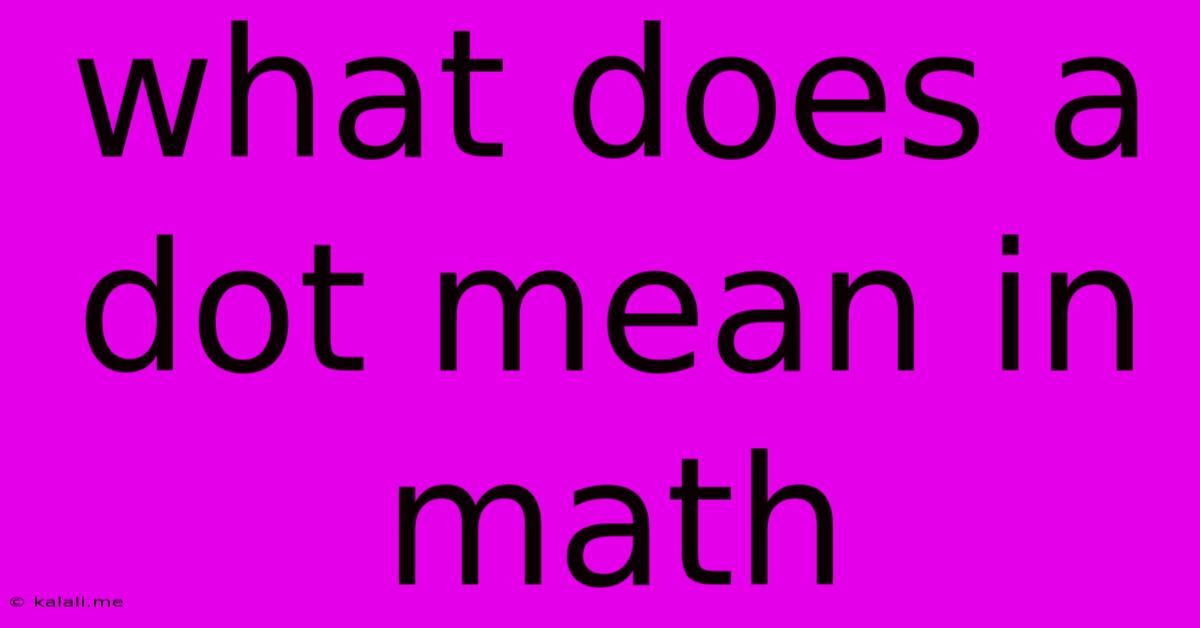What Does A Dot Mean In Math
Kalali
May 21, 2025 · 3 min read

Table of Contents
What Does a Dot Mean in Math? A Comprehensive Guide
A seemingly simple symbol, the dot (•) in mathematics holds a surprisingly diverse range of meanings depending on context. Understanding its various interpretations is crucial for accurate mathematical comprehension. This article explores the multifaceted role of the dot in mathematical notation, clarifying its uses in multiplication, decimal points, scalar products, and set theory.
Understanding the context is key to deciphering the meaning of a dot in a mathematical expression. Let's delve into the most common uses:
1. Multiplication: The Simple Dot
Perhaps the most frequently encountered use of a dot in math is as a multiplication symbol. It serves as an alternative to the traditional "x" symbol, particularly when dealing with variables. This is especially helpful to avoid confusion, as "x" is commonly used as a variable itself.
- Example: 3 • 4 = 12 is the same as 3 x 4 = 12. Similarly, a • b represents the multiplication of variables 'a' and 'b'.
Using a dot for multiplication becomes particularly relevant in more complex equations involving multiple variables and operations to enhance readability and clarity. This prevents misinterpretations, especially when working with algebraic expressions.
2. Decimal Point: Separating Whole and Fractional Parts
The dot also acts as a decimal point, separating the whole number part from the fractional part of a decimal number. This is a fundamental concept in arithmetic and essential for representing numbers that are not whole integers.
- Example: 3.14 represents three and fourteen hundredths. The dot clearly divides the whole number (3) from the fractional part (0.14).
The consistent use of the decimal point ensures clarity and accuracy in numerical representation, avoiding ambiguity and errors in calculations involving decimals.
3. Scalar Product (Dot Product): In Linear Algebra
In linear algebra, the dot placed between two vectors signifies the scalar product or dot product. This operation results in a single scalar value rather than a vector. The dot product has applications in various fields, including physics and computer graphics.
- Example: Let's consider two vectors, u = (u₁, u₂) and v = (v₁, v₂). The dot product u • v is calculated as: u • v = u₁v₁ + u₂v₂.
The scalar product is a crucial concept in vector calculus and provides a way to measure the relative orientation and magnitudes of vectors. Understanding this application of the dot is vital for advanced mathematics and related fields.
4. Set Theory: Representing Elements
In set theory, a dot can represent an element within a set. This use is less common than multiplication or decimal points, but crucial for understanding set notation.
- Example: If A = {1, 2, 3}, then we can say that 2 ∈ A. While not a dot directly, the symbol '∈' signifies membership and is visually similar.
This notation clarifies the relationship between elements and sets and is foundational in discrete mathematics and its applications.
Conclusion: Context is King
The humble dot, while seemingly insignificant, plays a crucial role in numerous mathematical contexts. Understanding its various interpretations—as a multiplication symbol, a decimal point, a scalar product operator, or a representation of set elements—is essential for accurate mathematical understanding and problem-solving. Always consider the context of the mathematical expression to determine the correct meaning of the dot. This nuanced understanding will improve your mathematical fluency and ability to tackle complex equations and problems.
Latest Posts
Latest Posts
-
Is 2mm A Lot Of Rain
May 21, 2025
-
What Is A Substitute For Curry Powder
May 21, 2025
-
How To Get Wood Glue Off
May 21, 2025
-
Countries With No Extradition To Uk
May 21, 2025
-
Scripture About Footprints In The Sand
May 21, 2025
Related Post
Thank you for visiting our website which covers about What Does A Dot Mean In Math . We hope the information provided has been useful to you. Feel free to contact us if you have any questions or need further assistance. See you next time and don't miss to bookmark.